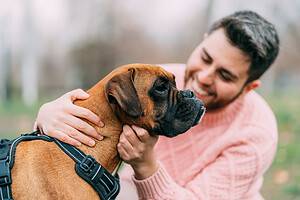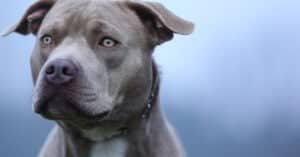Shar Peis were bred as working dogs who helped to herd and guard livestock, hunt, and protect people and their homes. They were also, unfortunately, also used in dog fighting.
In this article, we’ll discuss what Shar Peis were bred for, where they originate, how to care for them, and much more!
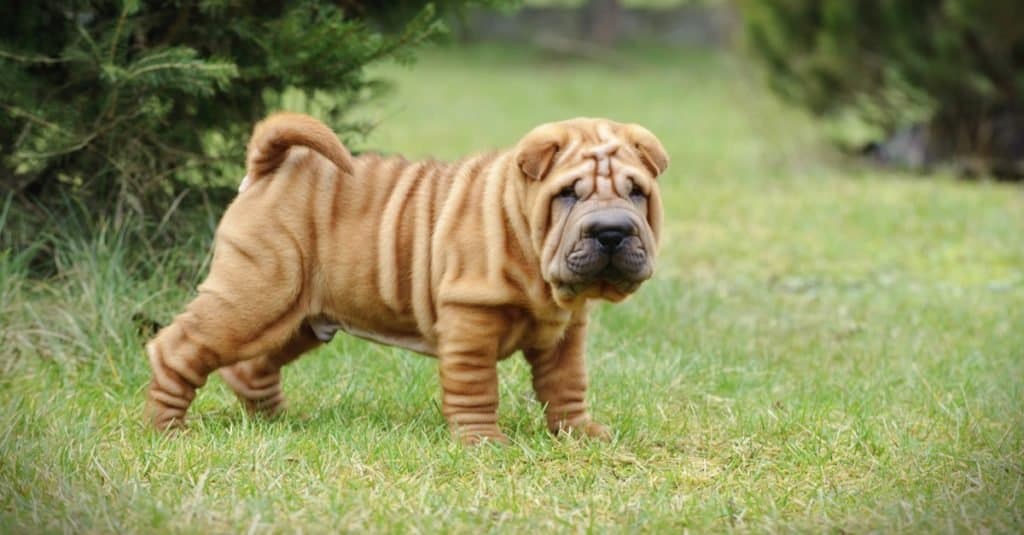
Shar Peis originally come from China, where they’ve been bred for over 2,000 years.
©Waldemar Dabrowski/Shutterstock.com
| Attribute | Value |
| Preferred Temperature | Mild climate; struggles in the cold and in the heat |
| Shedability | 3/5 |
| General Health | 1/5 |
| Size | 3/5 |
| Energy Level | 3/5 |
| Exercise needs | Moderate |
| Friendly with other dogs | 2/5 |
| Family and kid-friendliness | 3/5 |
| Trainability and obedience | 3/5 |
| Temperament | Affectionate, protective, and adaptable |
| Yappiness and barking | Moderate |
| Tendency to chew | 3/5 |
| Purebred cost to own | $1000-$1500+ |
| Dog Group | Non-sporting |
| Used for hunting | Yes |
| Intelligence | 4/5 |
| Hypoallergenic (nonshedding) | No |
| Life span | 8-12 years |
| Weight | 45-60 pounds |
| Height | 18-20 inches |
| Separation anxiety | Moderate likelihood |
Evolution and Origins of the Shar Pei
The Shar Pei breed is over 2,000 years old. They were first bred in ancient China, where they were kept by peasants and trained for a variety of tasks, including herding and guarding livestock on farms. They were also bred as hunting dogs, similar to beagles and Chihuahuas.
Shar Peis also have a history as fighting dogs due to their loose skin, which allows them unique flexibility when grabbed. This is similar to the history of the Pit Bull.
The breed gained popularity in the United States in the late 1900s and was recognized by the American Kennel Club in 1992.
Today, many Shar Peis don’t work or fight–they get to be pampered pets instead! They’re very adaptable but can be a challenge to train and aren’t recommended for the inexperienced.
Shar Pei Introduction
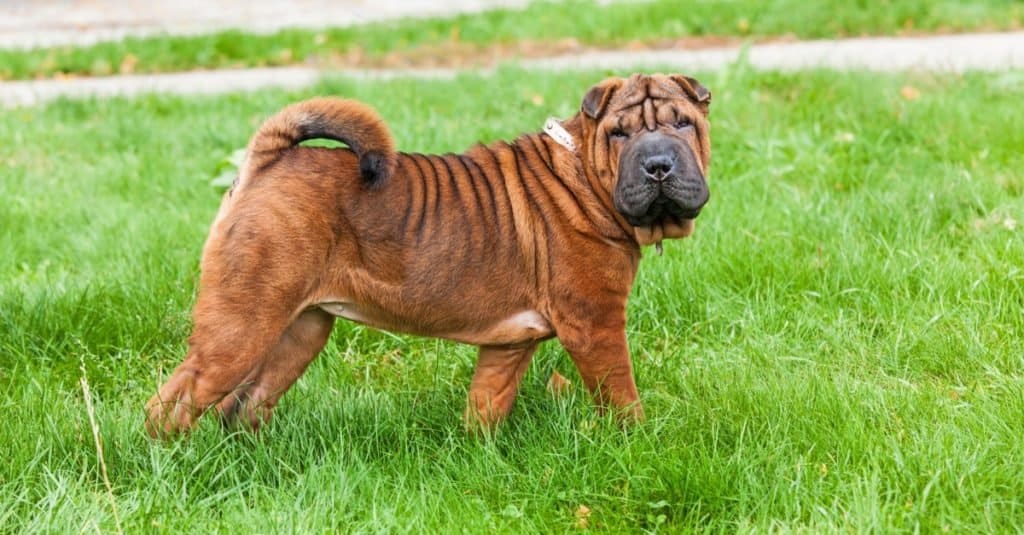
Shar Peis were bred as livestock guardians, herding dogs, hunting dogs, and fighting dogs.
©Alexeysun/Shutterstock.com
Shar Peis are thought to have been bred for a variety of work. This is because, in ancient China, the poor depended on dogs to help them throughout their daily lives.
Tasks assigned to the Shar Pei likely included hunting, herding, and guarding homes and livestock. They were also sometimes used for fighting.
In the 60s and 70s, Shar Peis nearly went extinct but were brought back from the brink due to a surge in popularity in the United States.
Today, Shar Peis can make for challenging pets. They have a stubbornness and aloof nature commonly seen in dogs who were bred to work on their own. These pups had to think for themselves!
Though they love their families and are affectionate, Shar Peis are also independent. They require a dog trainer who knows what they’re doing–not one who uses aversive methods or punishment.
Types of Shar Pei
There are three types of Shar Pei dogs:
- Horse-coat Shar Peis have short hair that bristles when rubbed in the wrong direction
- Brush-coat Shar Peis have longer fur and more wrinkled skin
- Bear-coat Shar Peis have fluffy coats with fewer skin wrinkles and are the rarest variety
Shar Pei Fun Fact
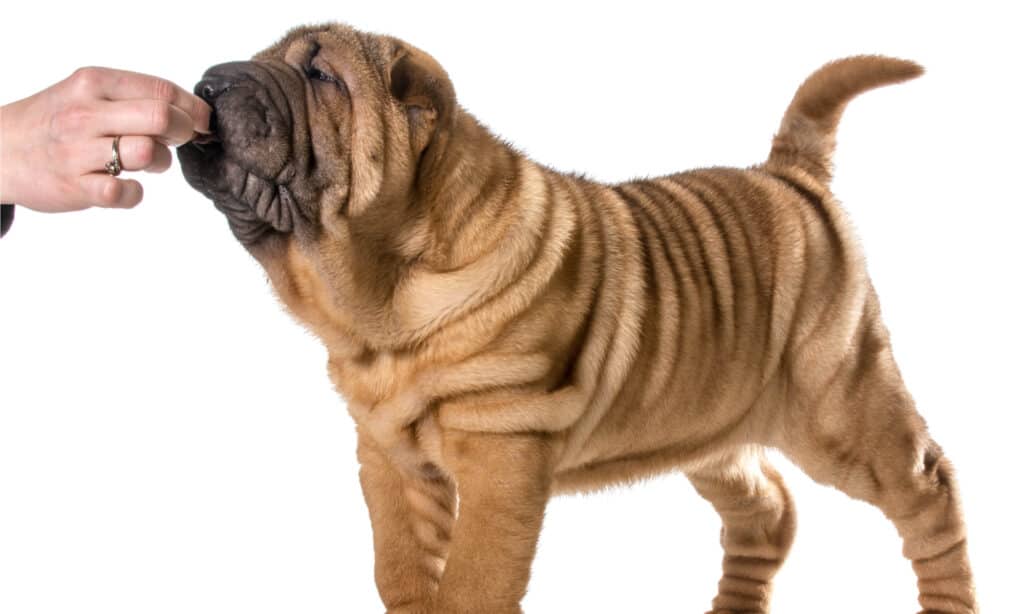
Shar Peis nearly went extinct in the 60s and 70s before the breed was revived.
©WilleeCole Photography/Shutterstock.com
In the 1960s and 1970s, the Shar Pei almost went extinct due to a dog tax in China. The Guinness Book of World Records listed it as the rarest dog breed at the time.
A breeder named Matgo Law saved the breed from extinction with the help of Life Magazine, which published a Shar Pei on its cover. This led to a major increase in Shar Pei’s popularity in the United States.
Pros and Cons of Owning Shar Peis
| Pros | Cons |
| Shar Peis are adaptable. They’re often happy with only a few short walks as their daily exercise and can be trained for a variety of tasks. | They’re difficult to train. Shar Peis are smart dogs with their own minds. They can be quite stubborn and require patience to train. |
| They see it as their job to protect their households. Shar Peis aren’t just large but also make great guard dogs due to their protective instincts. | They might be dog aggressive. Breeds with dog-fighting histories are sometimes distrustful of other dogs or outright hostile. |
| Their coats are easy to maintain. Though their wrinkles should be cleaned regularly to prevent infection, Shar Pei coats are super short and easy to keep up with. | Shar Peis aren’t very healthy. They’re prone to several health issues due to poor breeding, including difficulty breathing, brachycephalic airway syndrome, and skin infections. |
Best Food for Shar Peis
The best food for your Shar Pei is a quality, veterinarian-recommended diet. The brands most commonly recommended by veterinarians include Hills, Royal Canin, and Purina Pro Plan. However, there are also some cheaper foods on the market that are still quality.
Purina Pro Plan Sensitive Skin and Stomach is a good choice for Shar Peis as it helps to support skin health.
Consumer involvement in dog food is higher than ever, as we all want our pups to eat the best of the best. However, this has led to some harmful trends, such as grain-free diets, which have been linked to a heart condition called Canine Dilated Cardiomyopathy.
This is why I only take my vet’s word on the subject! It’s also why I refer to WSAVA guidelines, which state that dog foods should be formulated by a certified veterinary nutritionist and scientifically tested.
Size and Weight of Shar Peis
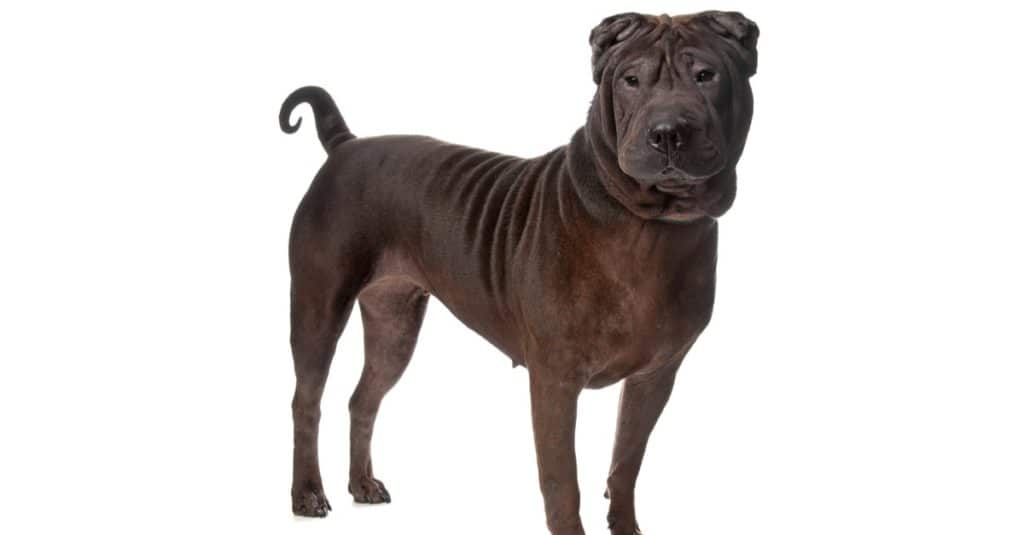
Shar Peis are medium-large dogs with muscular bodies.
©Erik Lam/Shutterstock.com
Shar Peis are medium-large dogs that stand between 18-20 inches and weigh 45-60 pounds. Females are often smaller than males.
| Height | 18-20 inches |
| Weight | 45-60 pounds |
Common Health Issues in Shar Peis
Skin Infections
The wrinklier your Shar Pei’s skin is, the more susceptible they will be to infections and other skin problems. Fungal infections can grow in skin folds that aren’t properly cleaned or dried after a bath. Therefore, proper grooming is important.
Brachycephalic Airway Syndrome
Brachycephalic airway syndrome, also known as simply brachycephalic syndrome, affects dogs with short muzzles like the Shar Pei. These pups have different facial structures that negatively impact their overall health, including stenotic nares, elongated soft palettes, and enlarged tonsils.
They often struggle to breathe, especially during vigorous exercise or in the heat. Shar Peis are more prone to heat stroke, exercise intolerance, dental problems, tracheal collapse, and other health issues.
Eye Disorders
Several eye disorders are common in the breed, which is true of many brachycephalic dog breeds. These include glaucoma, retinal dysplasia, and SARDS.
Luxating Patella
Luxating patella is when a dog’s kneecap slides out of place. A Shar Pei might limp or walk on three legs temporarily, then go back to normal when the knee slides back into its correct position. Surgery is used to treat this condition as it’s very painful for the dog.
Familial Shar-Pei Fever
Shar Pei Fever may impact as many as 23% of Shar Peis. Young dogs will develop frequent fevers, sometimes alongside other symptoms such as swelling of the hock or other joints, swollen muzzle, refusal or struggle to walk, and GI symptoms.
Amyloidosis
Amyloidosis occurs when a protein called amyloid builds up in a dog’s organs, impacting their ability to function.
Tight Lip Syndrome
Tight lip syndrome is an overbite caused by a birth defect, which can cause a dog to bite their own lip and, in rare cases, impacts their ability to eat. Surgery is recommended to correct this while the dog is young.
Other Conditions
Shar Peis are also more likely to develop some other conditions such as heart disorders or thyroid disease.
Shar Pei Temperament
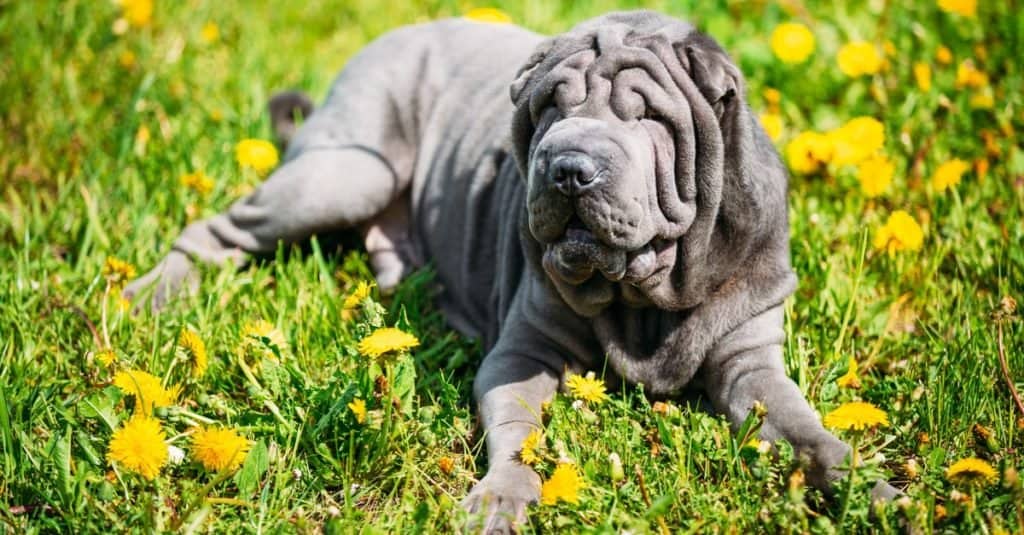
They are known for being loyal and affectionate with their families but fierce when facing a threat.
©Grisha Bruev/Shutterstock.com
Shar Peis are independent and can act quite aloof. They’re smart and have their own minds because that’s how they were bred to be! Following directions can be tough for them, but with patience, they can get there.
These dogs are fiercely loyal and protective. Early socialization is key so that your dog doesn’t try to “protect” you from the wrong things or become fearful in public settings.
They might also tend toward dog aggression due to their fighting history. Always introduce new dogs slowly and on a leash, and don’t leave them unattended until you’re confident they will continue to get along.
While Shar Peis may be stand-offish with strangers and take time to warm up to new people, once they love you, you’ll have a friend for life! They’re affectionate and sweet.
How to Take Care of a Shar Pei
Grooming
Shar Peis need to be brushed infrequently, but they do require other grooming maintenance. Bathe your dog at least once a month, cleaning their entire body including around their skin folds. Rinse and dry them well to avoid skin infections.
Their nails should be trimmed once weekly, according to the American Kennel Club, and their ears cleaned at least once a month.
Since Shar Peis are prone to dental disease, it’s important to brush their teeth daily and to speak to your veterinarian about the frequency of professional dental cleanings.
Training
Shar Peis can be quite stubborn, so it’s important to always use force-free training techniques. Don’t buy into anyone who says you need to become the alpha or dominate your dog, as these methods promote fear and aggression.
Keep training sessions short, fun, and engaging. Stop when your Shar Pei becomes bored, or one of you grows frustrated. Whenever possible, end a training session on a high note!
Exercise
Shar Peis are pretty adaptable when it comes to exercise, tolerating anything from a few short daily walks to a more active lifestyle. It’s all in what they’re used to, though–don’t expect them to go without exercise for a month and then tolerate a long hike!
They can also struggle with exercise due to their short snouts. When it’s hot outside, time your walks for the cooler parts of the day, like early morning or late evening. Sometimes, you may have to skip walks altogether and focus on indoor activities.
Never push your Shar Pei to do more than they can handle, as this can cause heat stroke and other health challenges.
Shar Pei Puppies
Shar Pei puppies require short bursts of activity rather than the long stretches of exercise that adult dogs can handle. They should be fed a diet tailored to their specific age group.
Work on socialization and manners at a young age so that your puppy can develop into a confident and well-mannered adult dog.
The average Shar Pei litter is four to six puppies. Don’t separate puppies from their mother and siblings before eight weeks of age.
Shar Peis and Children
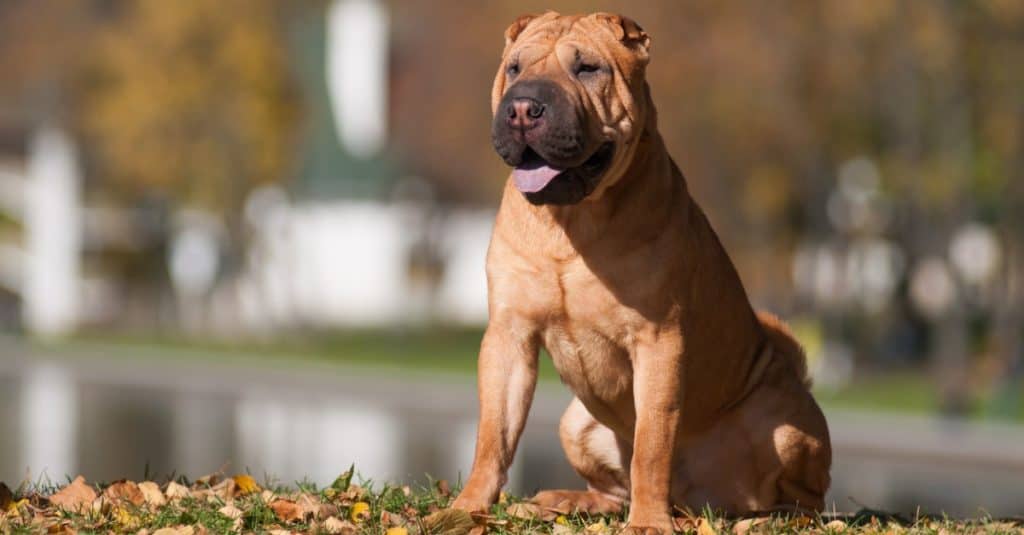
Shar Peis do best with children if socialized from a young age.
©David Raihelgauz/Shutterstock.com
One challenge you might face with Shar Peis and children is herding. They can also be very protective, so be sure they don’t try to guard family members from one another.
As with any large dog, accidents can happen during rough play. Puppies are always nippy to some extent, and Shar Peis can easily knock over young children even without meaning to. Never leave any dog unsupervised with a child.
Teach your child and dog how to interact kindly and safely with one another. Kids should be taught never to get in a dog’s face or touch their food and to use gentle hands when petting a dog. Dogs should be taught not to jump on people or herd or roughhouse with little ones.
Dog Breeds Similar to Shar Peis
Some dogs that look similar to the Shar Pei with wrinkles and squished faces include pugs and Chow Chows. Other guard dog breeds include Akitas, American Pit Bull Terriers, German Shepherds, and Great Danes.
Popular Names for Shar Peis
- Bella
- Luna
- Bear
- Max
- Bailey
- Lucy
- Sam
- Charlie
- Harley
- Lola
Thank you for reading! If you have feedback on this post, please contact the AZ Animals editorial team.
The photo featured at the top of this post is © Alexeysun/Shutterstock.com
Ready to discover the top 10 cutest dog breeds in the entire world?
How about the fastest dogs, the largest dogs and those that are -- quite frankly -- just the kindest dogs on the planet? Each day, AZ Animals sends out lists just like this to our thousands of email subscribers. And the best part? It's FREE. Join today by entering your email below.
Thank you for reading! Have some feedback for us? Contact the AZ Animals editorial team.




